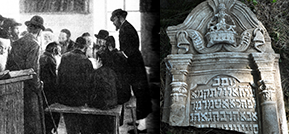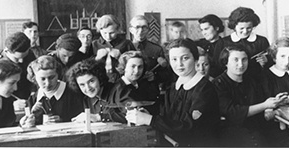The Story Behind the Tombstone in Bolekhiv

For many years, the Jewish Galicia and Bukovina Organization has been documenting tombstones in Jewish cemeteries in Galicia and Bukovina. These tombstones are the last, quite sad, testimony to the lives and deaths of thousands of Jews, men and women, scholars and laymen, elderly and children, who lived for many generations in the cities and towns of this area.
The epitaphs on these tombstones reveal only a few biographical details and are usually worded uniformly: the deceased’s name and the name of their father, date of death, implicit reference to the social or religious status of the deceased, and the blessing for the dead – “May his/her soul be bound in the bond of eternal life.” In most cases, the circumstances of the deceased’s death, their life history, and details of their family and occupation are not included in the inscription. However, occasionally these epitaphs allude to dramatic events from the forgotten past of the townspeople, and even more rarely, these clues intersect with evidence from other sources and allow us to recreate the story behind the tombstone. This is what transpired with the tombstone of Dov Ber ben Aryeh Leib who was buried in the cemetery in the town of Bolechów (Bolekhiv) in the middle of the 18th century.
Dov Ber’s tombstone is interesting in several respects. It is a beautiful work of art – the façade of the tombstone is completely covered with decorative engravings of leaves and floral wreaths, a true artistic masterpiece in the elegant Baroque style that dominated European art at the time. This works stands out even among a rich artistic landscape of dozens of Baroque style tombstones in the Bolechów cemetery. But no less fascinating is the very moving and rhyming engraved inscription on the tombstone, written in stylish letters:
תנקום Avenge
דם הנשפך Blood spilled
כמים המוגרים As flowing waters
פה נחו ישרים Here rest the righteous
אוי לנשארים Woe to those who remain
ה"ה הקדוש התו The saintly and learned one
הרבני מ"ו דוב Our rabbi and teacher Dov
בער בה ... מו Ber son of…our teacher
אריה ליב ...ר Aryeh Leib
...יג תמוז ת T13 Tammuz `
תהצבה May his soul be bound in the bond of eternal life
.
Thus, this was not a common person: the grandiose titles used in the language of the inscription unequivocally indicate the man was a scholar and judging by the richness of the engravings on the tombstone, he came from an established family. Furthermore, the call for blood revenge, as well as the referral to the deceased as a saint reveal the circumstances of his death – Dov Ber was murdered by gentiles. We cannot learn the details of this tragic event – the death of a scholar in the Bolhov community – from the tombstone. Even the year of the event cannot be determined since the date on the tombstone has been partially erased.
However, as previously mentioned, occasionally the facts of events not revealed by the tombstone can be discovered using other sources from the period.
In the second half of the 18th century, Dov Ber Birkenthal, a wine merchant, scholar, and public activist, lived in the town of Bolechów. His impressive tombstone still stands in the center of the old cemetery. In addition to his economic and public activities, Birkenthal was also a writer and left behind a most fascinating memoir. Parts of this unique work were published in 1922 and parts of it remained as a manuscript, and it continues to serve historians as a wellspring of knowledge about the lives of Jews in Poland in the 18th century.
This was not an easy time for the residents of eastern Poland, particularly the Jews. The crumbling Polish kingdom became engrossed in constant civil wars. Ethno-confessional and class tensions betfor ween the Ukrainian population (mostly peasant) and the Polish population (landowners and city dwellers) developed into blood-soaked clashes. Gangs of Ukrainian burglars and rebels, “the Haydamaks” and "Opryshky", terrorized the residents of cities and towns in eastern Poland (present day Ukraine) and many Jewish communities fell victim to severe violence by the rioters. The wave of violence against Jews reached its peak in the year 1768 when organized Haydamak gangs captured the eastern city of Uman and slaughtered thousands of its Jewish and Polish residents. Cities and towns in other places in Podolia, Volyn, and Galicia also suffered many attacks by Haydamak and Opryshky (in Galicia) groups during these years. In all of these cases, Jews were marked as targets for robbery and harm by the rioters. On the 13 of Tammuz (the 13th of July) 1759 group of 28 opryshkies stormed the city of Bolechów. What happened then is described in detail in Dov Birkenthal’s memoirs, and from this story we also learn the fate of our Dov Bear son of Arie Leib (for Hebrew original see here):
It was at dawn, after the night watch had gone off to their houses... The band stopped before the house of the katzin [honorable person], R Nahman, and there found the fire made by the guards still burning. Near the fire the beadle of the community, R. Hirsh Schulklopper, was sleeping ... they ordered the beadle to call to the people in the house to open the door for him, so that they might not suspect the presence of the bandits... When the door was opened the robbers rushed into the rooms, where they found the son-in-law of R. Nahman, R. Abraham, the Rabbi of Dolina. R. Nahman had already fled to another room which had a strong vaulted ceiling, and with him his wife and daughter (Avraham’s wife) together with a woman attendant. Thus only Nahman's son-in-law fell into the hands of the bandits. He begged for mercy and tried to escape saying “I am only tutor to the children in the house of this wealthy man, and he will not give a farthing for my ransom; even if you kill me he will not care.” Meanwhile, the learned katzin, R. Ber, son of Aryeh Leib, awoke from his sleep, hearing that the robbers were in the town, and rushed out of his house in alarm, undressed except for his night-shirt. He tried to escape through the back gate of his house, hoping that the robbers would not notice him. But some of the robbers, who were keeping watch at the back gate of Nahman's house, saw Ber running away and caught hold of him by his shirt and brought him to their companions. He begged for mercy, promising to pay a handsome ransom for his life, and led the bandits to the vaulted chamber in the house of Nahman... Nahman himself, however ... had taken refuge with his wife, his daughter and a woman attendant in the vaulted cellar, the doors of which were of iron and were locked and barred with iron bars. The robbers tried to force these iron doors. R. Nahman then took his firearm and shot one of the band dead. This made the others furious and they started to break down the iron shutters with large pieces of stout wood and to get in by the windows... R. Nahman had to fire on them twice more with the two firearms he had in his hands... With one shot he wounded one of the robbers in the foot, and with the other he wounded the chief of the band, Ivan Boytchuk, below the chest, but not mortally. When the chief felt the pain of the wound, he commanded his fellows in Ruthenian: “Molodtzy, palitj”, that is to say, my lads, burn the house over his head!... The bandits then vented their anger upon the martyr Ber, who was still in their hands, together with R. Avraham. ... They believed …that R. Ber was a son of R. Nahman… and they beat him to death with their axes. A woman named Etti, daughter of Malkah, who was then the midwife, came and implored the bandits to spare Ber; and one of them struck her down with his axe, and she died on the spot on which R.Ber had fallen, in front of R. Nahman's house. They also murdered a certain Eisik, son of the shopkeeper Leib, who came to plead with them to spare his little shop; and the bodies of both Etti and Eisik were burnt… But R. Ber, although struck to earth, felt the heat of the fire, and had sufficient strength to drag himself away from the spot to the main street, were he expired, giving up his soul in holiness and purity. The people brought R. Ber's corpse to the synagogue and laid it on the large table placed at the entrance. This table now stands on the soythern side of the Beth-ha-Midrash; for more than thirty years the marks of the blood which had run from this martyr could be seen on it.
This R. Ber was once on his way to Breslau, at a time when Prince Martin Lubomirsky had set out on a plundering expedition, and had robbed many merchants and murdered not a few. R. Ber would have fallen into his hands, had it not been that a wheel of the cart was broken, and this accident delayed him a night… He returned home safety on Friday, the 11th of Tammuz, and on the Sabbath he was called to the Torah and recited the thanksgiving prayer for having been rescued. Because of our great sins he did not know that he was destined to die in his own house, which seemed to be a safe place. Though he had plenty of money with which to ransom himself, he could not annul the decree, and he died at the early age of thirty-six. He was a man of learning, strong and wealthy, tall, well built and handsome. He left not his like in our community, and since his death there has been none like him…
The Rabbi of Dolina was still held by the bandits, who spared him on his promising to show them the houses of other rich Jews besides Nahman. He guided them to [such a house]; both [owners] had escaped with their families when they learned that the robbers had come to the town. The robbers, finding an empty house, started to loot it, and while they were thus engaged Avraham escaped to the other side of the river and joined the other Jews who had fled thither…
...[after having looted additional Jewish houses and wounded two Jewish women (amog them the author's wife] the band had left the town triumphantly a little before midnight on the Sunday…
(The Memoirs of Ber of Bolechow, Translated by M. Vishnitser, New York, 1973, pp.97-99. Further details of the incident taken from Polish legal sources can be found in the article: Gershon David Hundert, "Bandits in Bolechów: eighteen –century Jewish memoirs in context", Jewish History 22 (2008), pp.374-385).
Hence it turns out that Dov Ber, son of Aryeh Leib, “the saint, Rabbi, and Torah scholar” was a prominent figure in the Bolechów community. He was captured and murdered by the Ukrainian rebels on July 13th, 1759 and this tragic event caused intense mourning among the Jews of the city. Unusual evidence from the memoirs of a contemporary of the time reveals a haunting and tragic story hidden behind the engraved epitaph of a tombstone. We have no doubt that this discovery is but one of many of awaiting researchers in Jewish cemeteries of Galicia.
(We are grateful to prof. Gershon Hundert from McGill University for drawing our attention to this distinct tombstone, one of about 1,500 tombstones that were documented by JGB team in 2013 and 2014 years)






